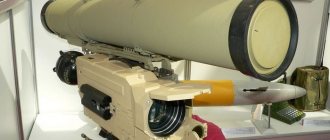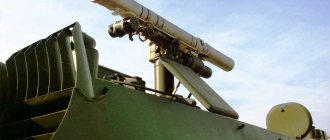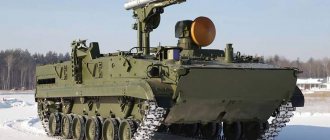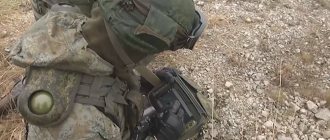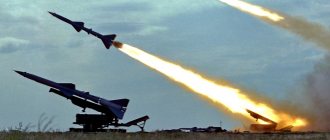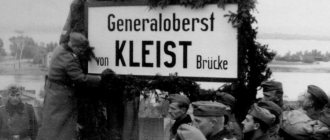The very first examples of anti-tank guided missiles (ATGMs) appeared in Germany in the 1940s. For the first time, the development of weapons began in the laboratories of the company, which is now producing world-famous BMW cars. According to the engineers, it was supposed to become a huge headache for all tankers. However, pre-production samples, which were ready by the end of 1943, called “Little Red Riding Hood”, were tested on the Eastern Front in 1944, but the ATGM data was never received from the series. The Nazi leadership considered their release inappropriate.
Soviet design minds invented ATGMs much later: “Phalanx” (1967) and “Dragon” (1968), which, despite their loud names, did not glorify themselves with special glory in combat use. In the 70s, a new guided missile with a very unusual name entered service, part of a complex that is still considered a threat to tanks - the Konkurs ATGM.
History of creation
In mid-1966, the Ministry of Defense Industry realized the fact that the first generation of anti-tank missiles did not fit, first of all, into the lethal range standards of that time. The fire contact distance of 2.5 km was considered insufficient. But, as they say, a bird in the hand is better than a pie in the sky; the above-mentioned missiles were adopted for service.
9K111 Bassoon
A competition was announced among design bureaus, the results of which were to produce a second-generation anti-tank missile system. The military commanders wanted to get a sample manufactured according to the principle of “cheap and high quality”, and told the competitors about the technical requirements that they wanted to see in the final version of the sample.
The speed of the rocket was supposed to exceed the speed of sound by 1.5 times, have a wired control system and destroy enemy equipment at a range of 4 kilometers.
At the same time, the military wanted the manufacturability of the process to not require large financial investments.
At the same time, the materials and technologies used by designers in the production of the defense industry clearly could not allow the production of a rocket of the given parameters. And in order to realize the wishes of the leadership, it was necessary, at least, to attract the efforts of wizards.
ATGM "Competition"
A representative of the Tula Instrument Design Bureau undertook to explain to the commanders about the expediency of the military’s demands in relation to production technologies in his presentation of the analysis of their technical specifications for the rocket. After this, the requirements decreased. Supersonic speed was replaced by subsonic speed, due to which the weight and financial investment in the manufacturing process were reduced. The development of the complex was entrusted to the Tula Instrument Making Plant.
The engineering team behind the design included musical instrument aficionados because they initially named their projected model the “Oboe.” The Bassoon system, already developed by that time, was taken as a basis.
The new ATGM did not differ much in terms of technical data, before the start of radical improvements, which began in 1969.
The innovations turned out to be so successful that the plant stopped considering the project a deep modernization of the Bassoon and a year later, in 1970, the model was given a new name “Konkurs”, perceiving it as a separately designed model.
Testing of the new “tank threat” continued for another three and a half years. Designers honed the complex to an ideal state year after year. As a result, after a successful demonstration of the Konkurs ATGM to military representatives, at the beginning of 1974, an order was issued by the Minister of Defense to accept the complex for service.
Operators
- Azerbaijan Azerbaijan - 20 9P148 combat vehicles and 400 9M113 missiles
- Algeria Algeria - a number of 9K111-1 “Competition” complexes, as of 2010,
- Armenia Armenia - 9 9P148 combat vehicles, as of 2016
- Belarus Belarus - a number of 9K111-1 “Konkurs” complexes, as of 2010
- Bulgaria Bulgaria - 236 complexes 9K111 "Fagot" and 9K111-1 "Konkurs", as of 2010, 400 ATGM 9M113 were produced under license for the period from to 1996
- Hungary Hungary - 100 combat vehicles and 2060 9M113 missiles were supplied from the USSR between 1988 and 100 9K111-1 Konkurs complexes are still in service as of 2010
- Guinea Guinea - a number of 9M113 ATGMs, as of 2010
- Georgia Georgia - some 9M113, as of 2017
- GDR GDR - 52 9P148 combat vehicles were supplied from the USSR in the period from to 1983, 11,200 9M113 missiles were supplied from the USSR in the period from to 1989
- Egypt Egypt - 580 9M113 missiles for Fahd armored personnel carriers supplied from Russia between 1995 and 1995
- India India - 110 SPTRK based on BRDM-2 with 9M111 and 9M113 missiles (presumably 9P148), as of 2010, 1000 9M113 missiles were supplied from the USSR between 1991 and 1991. 25,000 9M113 missiles ordered from the USSR in 1988, produced under license since 1992 (including the 9M113M version), as of 2011, 12,800 missiles were produced
- Iraq Iraq - were in service with the Iraqi army during the Gulf War
- Iran Iran - a number of 9K111-1 “Konkurs” complexes, as of 2010, missiles are produced under license under the designation Towsan-1, between 2011 and 2400 9M113 units were produced
- Kazakhstan Kazakhstan - a number of 9K111-1 “Konkurs” complexes, as of 2010
- Kyrgyzstan Kyrgyzstan - 12 units 9K111-1 “Competition”, as of 2016
- DPRK DPRK - a number of 9K111-1 “Konkurs” complexes, as of 2010
- Cote d'Ivoire Cote d'Ivoire - a number of 9K111-1 "Competition" complexes, as of 2010
- Libya Libya - a number of 9K111-1 “Competition” complexes, as of 2010
- Moldova Moldova - 19 9K111-1 “Competition” complexes, as of 2010
- Morocco Morocco - 100 9M113 missiles delivered from Russia in 2001
- Poland Poland - 800 9M113 missiles were supplied from the USSR between 1989 and 1989; as of 2010, 18 9K111-1 Konkurs complexes are still in service
- Russia Russia: Ground Forces of the Russian Federation - a number of 9K111-1 “Konkurs” complexes, as of 2010
- Coastal forces of the Russian Navy - 72 complexes 9K11 "Malyutka" and 9K111-1 "Konkurs", as of 2010
Device
The Konkurs ATGM consists of three components of equal importance. First of all, this is a combat vehicle, on the turret of which the “Competition” was located.
The armored vehicle was created on the basis of the BRDM-2 and is called BM 9P148.
In it, the turret compartment was completely re-equipped and adapted for an anti-tank complex.
The second component of the “Competition” is the 9P135 launcher. It consists of stationary fasteners, brackets, five containers and radio-electric components, which are connected to a control panel located inside, at the gunner’s position.
The third component of the “Competition” is the 9M113 rocket. It is placed in containers on the launcher. The launch occurs only after a command is given by the operator of the implement.
You can fire at enemy armored targets not only from the BM 9P148, but also from the machine gun. The Konkurs ATGM can be equipped with motorized rifle units that have a shortage of military equipment when conducting defensive operations. In this case, the “Konkurs” is installed on the BMP-2, or the missile is fired by an operator from a tripod mounted on the ground.
Description
The Konkurs ATGM is a regimental-level anti-tank system that can successfully destroy enemy armored vehicles and fortifications at a distance of four kilometers.
The missile system consists of several components:
- combat vehicle (BM) 9P148;
- launcher 9P135M;
- guided missile 9M113.
The launcher includes: control and guidance equipment, a trigger mechanism and a machine tool. The 9P135M launcher houses five launch containers, each of which is discarded after firing. If firing occurs from the BM 9P148, then voltage is supplied from the vehicle’s power supply to the electric igniters of the on-board power supply, to the second ground battery of the power supply and the powder charge of the coordinator rotor. After about ten meters of flight, the main engine turns on.
The horizontal guidance angle is 360°, and the vertical one is -5...+20°.
There is also a portable launcher, which is part of the armament of the self-propelled complex. It consists of a machine, control equipment and a trigger mechanism. Her weight is 22 kg.
The 9M113 guided missile has a classic canard aerodynamic design. Its caliber is 135 mm. Four large folding wings are located at the rear of the rocket, and four control surfaces are located at the front. Also in the nose of the rocket are the rudder drives and the shaped charge. In flight, the rudders and wings are located at a certain angle to the longitudinal axis of the rocket, which causes it to rotate, stabilizing the flight.
A solid propellant engine is installed in the middle part of the ATGM; the control equipment is located at the rear. The rocket engine is a single-chamber dual-mode engine. At the rear there is a coil of wire and an infrared lamp, which is used by tracking equipment to locate the missile in flight. The only complex device in the rocket design is the coordinator, which includes a gyroscope.
After the shot, the missile's infrared lamp is fixed by the control equipment. After which the automation determines the position of the projectile in space and makes corrections to the flight. The signal is transmitted through the wire and enters the steering actuators. The operator must simply hold the object in sight. In addition to semi-automatic, there is also a manual mode for correcting the missile’s flight at its final stage, this significantly increases the accuracy of the complex.
Tactical and technical characteristics of the Konkurs ATGM
A comparison of the characteristics of the Soviet and American missiles shows the advantage in range of domestic weapons. In addition, the Konkurs is capable of hitting high-speed targets.
| Characteristic | ATGM "Competition" | ATGM "Javelin" |
| ATGM "Javelin" | 15 | 16 |
| Container length, m | 1.26 | 1.2 |
| Operating principle | Cumulative jet | Cumulative jet |
| Firing range | 4 km during the day and 3.5 km at night | 2 km |
| Rocket flight speed, m/s | 250 | 150 |
| Armor penetration, mm | 600 (angle of impact 900) 250 (angle of impact 600) | 500 (impact angle 900) 200 (impact angle 600) |
| Maximum target speed, km/h | 60 | 40 |
The Soviet missile has slightly better armor penetration characteristics. Increased flight speed ensures early target engagement.
Notes
- , With. 187.
- , With. 174.
- Spandrel
literally means “above structure”, “sinus of the vault”. - ↑
- ↑. Official website of the Tula Arms Plant. Retrieved January 27, 2013.
- The Military Balance 2010. - P. 176.
- The Military Balance 2010. - P. 245.
- The Military Balance 2016. - P. 178.
- The Military Balance 2010. - P. 178.
- The Military Balance 2010. - P. 122.
- ↑ Error in footnotes?: Invalid tag ; no text provided for footnotes
- The Military Balance 2010. - P. 140.
- The Military Balance 2010. - P. 311.
- The Military Balance 2022. - P. 205.
- The Military Balance 2010. - P. 360.
- . MESHWAR. Retrieved August 21, 2012.
- The Military Balance 2010. - P. 251.
- The Military Balance 2010. - P. 365.
- The Military Balance 2016, p.187
- The Military Balance 2010. - P. 412.
- The Military Balance 2010. - P. 302.
- The Military Balance 2010. - P. 262.
- The Military Balance 2010. - P. 188.
- The Military Balance 2010. - P. 153.
- The Military Balance 2010. - P. 223.
- The Military Balance 2010. - P. 227.
- The Military Balance 2010. - P. 157.
- The Military Balance 2010. - P. 272.
- The Military Balance 2010. - P. 159.
- The Military Balance 2010. - P. 372.
- The Military Balance 2010. - P. 189.
- The Military Balance 2010. - P. 125.
- The Military Balance 2010. - P. 196.
- The Military Balance 2010. - P. 307.
Operating principle
Thanks to the infrared lamp, which illuminates the target while aiming, the launcher (via electronics) receives a command that adjusts the missile and launches at the most advantageous moment. All that is required of the gunner operator at this stage is to keep the target on sight.
After the operator presses the “Start” button, the electronics and squibs are sequentially triggered, after 0.2 seconds the container lid opens and the 9M113 missile rushes towards the target.
In order for the target to be hit, it is necessary to keep it in sight until the missile directly hits it.
There are two flight control modes for the 9M113 missile. In “Semi-automatic mode” the target is illuminated due to the automatic launcher. But this is not the most reliable option, which is why the vast majority of operators use “Manual Mode”.
In this case, the complex gunner himself controls the process of adjusting the 9M113 flight using optical sights and special control knobs.
This complex was nicknamed the “thunderstorm of tanks.” A hit by a 15 kg missile often leads not only to the transfer to the status of “not combat-ready unit” of equipment that recently posed a threat, but also to its complete destruction. But not only enemy tanks should be afraid of the “Competition”.
With skillful actions of the operator's gunner in the air, low-flying airplanes and helicopters are unlikely to find salvation.
And on the water, enemy boats and even small ships will not reach their target. The Konkurs ATGM is a striking example of a powerful Russian anti-tank weapon, and this complex is still feared by all tankers in the world.
Compound
Combat vehicle 9P148
Main article
9P148 “Competition” Launcher 9P148
Launcher body 9P148
The Konkurs ATGM is modified in relation to the basic
BRDM-2
.
The changes ensure the placement of the launcher, sighting device, as well as electric drives for their guidance and synchronization. A cutout was made in the original body roof sheet for the exit of the launch guides. The cutout is covered by a rectangular electrically operated hatch. The commander's hatch contains a 9Sh119
with the ability to quickly move roughly manually along the horizon, or smoothly track the target using an electric drive.
The sight in the stowed position is closed by an armored shutter with a manual drive. In order to protect the optics, there is a “combat glass” that is opened only during combat work, also manually. A light filter is provided to protect the gunner's vision from the effects of light radiation from a nuclear explosion, laser radiation, etc. The filter drive is also manual.
Launcher 9P135
Starting guides on the roof of the 9P148 housing
Hardware part of the 9P148
made on the basis of portable installation units
9P135
placed in the housing.
Also included in the kit is a 9P56
from the portable version. Thus, it is possible to fully use the anti-tank system outside the combat vehicle, for which it is necessary to dismantle the sighting device, control equipment, remove the machine from the stack and assemble the launcher. No special tools are required for this - all blocks are secured with wing nuts, the sight is removed upward through a special hatch in its turret using a standard turret key.
In addition to standard installation blocks 9P135
, the BM “Competition” contains special blocks:
- light interference indication unit (allows you to detect light interference that interferes with the semi-automatic guidance of the missile at the target);
- built-in equipment for monitoring and testing starting circuits;
- electromechanical guidance and synchronization drives.
The ability to test start-up circuits allows you to check the performance of the entire start-up procedure chain without actually starting up the products. Since the recoilless principle is used to launch a rocket, the launch is accompanied by the emission of a flame torch from the end of the container at approximately 10-15 m. In this regard, reliable insulation of the engine and combat compartments from the effects of flame is extremely important. Checking the start-up circuits allows you to diagnose malfunctions of the air intake protective shutter reset mechanism, breaks in the lines of the limit switches of the “travelling” locking mechanisms and the signaling for closing crew hatches and weapons.
ATGM 9M113
ATGMs 9M14P1, 9M113M and 9M113 in the Tula State Museum of Weapons
Missiles of the 9M113
, 9M111 (and their modifications) are widely described in the literature. The startup process deserves a separate description. Complicated at first glance, it ensures the product is launched only after all the procedures necessary for a reliable start have been fully worked out, and excludes the product from being launched in the event of any malfunctions.
- When the operator presses the “start” button, the electrical circuit of the squib of the hinged front cover of the TPK is closed, the cover opens, releasing the push rod of the squib contact of the power supply compartment (it also contains the Ш9 connector, which ensures switching of the electrical circuits of the rocket and the combat vehicle).
- Under the influence of the squib pulse, the separated batteries close and supply power to the on-board network of the product. The gyro powder generator ignites. After spinning up the gyroscope to operating speed (about 10,000 rpm), the inertial contactor switches the fuse of the expelling charge.
- The expelling charge ignites, pushing the product out of the TPK.
- The main engine is ignited by its own inertial contactor after the missile reaches a speed of about 300 m/s (which occurs at a distance of approximately 70 m from the firing position).
Models[edit]
- 9M113 Competition
(NATO:
AT-5 Spandrel
,
AT-5A Spandrel A
) - 9M113M Konkurs-M
(NATO:
AT-5B Spandrel B
) Tandem warhead - with an extended explosive probe.
The armor penetration of the warhead is 750–800 mm against missiles. Adopted into service in 1991. [6] Rocket 9M113M
1990 Tandem (800 mm (behind the air defense echelon)). 4000 m (3500 m at night (passive)). [6] - Towsan-1
,
Tosan
,
Towsan
or
M113
: Iranian licensed copy [2] 9M113M Konkurs-M (AT-5B Spandrel B). [7] Introduced in early 2000. [4] [8] It is unclear if it is still in production. [9] [10] Used primarily by paratroopers and armored vehicles. [eleven] - 9N131M1
-
warhead
. [2] - 9N131M2-1
-
warhead
, the newest modernized version. [2]
Links
Self-propelled "Phalanx" • "Bumblebee" Artillery "Centimeter" • "Daredevil" Aviation "Phalanga-N" Second generation Portable “Bassoon” • “Metis”/“Metis-M” • “Cornet” Self-propelled “Konkurs”/“Konkurs-M” • “Chrysanthemum” • “Sturm-S” Artillery “Kastet” • “Krasnopol” • “Gran” • “Kitolov” Aviation “Sturm-V” • “Attack-V” • “Whirlwind” • “Threat” Tank "Dragon" • Bastion • "Sheksna" • "Fable" • "Cobra" • "Reflex"/"Reflex-M" • "Invar"/"Invar-M" • "Svir" • “Arkan” • “Zenith” • “Rupture” • “Falcon-1”
Third generation Portable "Autonomy" • "Kornet-MR" Self-propelled "Hermes" • "Cornet-LR" Artillery "Beta" • "Firn-1" Aviation "Hermes-A" Tank • Pistols • • • TKB-023 • TKB-160 • TKB-205 • TKB-263 • TKB-412 • • APS • APB • PSM • • OTs-35 • TKB-506 • OTs-21 • OTs-23 • OTs-27 • OTs-33 • P-96 • GSh-18 Submachine guns PPT-27 • LAD • PP-90 • PP-90M1 • TKB-0247 • PP-93 • TKB-0102 • TKB-0104 “Bouquet” • TKB-486 • OTs-02 • OTs-22 • OTs-36 • OTs -39 “Baksanets” • OTs-53 • PP-2000 • OTs-69 Slot machines TKB-03 • TKB-09 • TKB-010 • TKB-011 • TKB-022 • TKB-059 • TKB-060 • TKB-072 • TKB-0106 • TKB-0110 • TKB-0111 • TKB-0116 • TKB- 0136 • TKB-0144 • TKB-0146 • TKB-408 • TKB-415 • TKB-497 • TKB-454 • TKB-517 • TKB-590 • TKB-790 • OTs-12 • 9A-91 • OTs-14 • A-91 • ADS • ASH-12 Rifles and carbines SVT-38 • SVT-40 • TKB-270 • TKB-392 Hunting rifles and carbines MTs18 • MTs-30 • MTs-106 • MTs-109 • MTs-110 • MTs-111 • MTs-200 • MTs-255 • OTs-18 • OTs-25 • OTs-31 • OTs-51 • OTs-63 Combat and service rifles RMB-93 • OTs-28 • OTs-62 Sniper rifles SVU • VSK-94 • MTs-116M • TKB-386 • TKB-0145K • TKB-579 • OSV-96 • OTs-44 • OTs-48 • OTs-95 Grenade launchers GP-25 • GP-30 • SPG-9 “Spear” • RG-6 • RPG-16 • AGS-30 • TKB-0249 “Crossbow” • TKB-048 “Iskra” • TKB-075 • MRG-1 “Ogonyok” » • DP-61 “Duel” • TKB-0134 “Kozlik” • DP-64 “Nepryadva” • RPG-22 • RPG-27 • TKB-0217 “Avalanche” • GM-94 • PUS-7V • RPG-29 • Boer Machine guns • ShKAS • ShVAK • Sibemas • • TsKVSV-19 • YakB-12.7 • TKB-01 • TKB-015 • TKB-020 • TKB-041 • TKB-061 • TKB-67 • TKB-138 • TKB-149 • TKB-160 • TKB-440 • TKB-458M • TKB-464 • TKB-481 • TKB-516 • TKB-521 • TKB-523 • NSV-12.7 “Utes” • GShG • A-12.7 Aircraft guns and guns SHVAK • B-20 • Sh-3-23 • VYA-23 • AM-23 • TKB-0105 • TKB-180 • TKB-198 • TKB-199 • TKB-369 • TKB-385 • TKB-437 • TKB- 446 • TKB-447 • TKB-494 • TKB-495 • TKB-499 • TKB-500 • TKB-501 • TKB-504 • TKB-505 • TKB-507 • TKB-508 • TKB-513 • TKB-515 • TKB-529 • TKB-532 • TKB-539 • TKB-540 • TKB-564 • TKB-567 • TKB-577 • TKB-700 • TKB-701 • TKB-717 • AK-630 • GSh-23 • GSh- 6-23 • GSh-30-2 • GSh-30-1 • GSh-6-30 • 6K30GSh • 2A28 • 2A38 • 2A70 • 2A72 Missile systems 2A28 "Thunder" • 9K111 "Bassoon" • 9K111-1 "Konkurs" • 9K115 "Metis" • 9K116 "Kast" • 9K119 "Reflex" • 9K121 "Whirlwind" • 9P132 "Grad-P" • 9K135 "Cornet" • 9P163 “Quartet” • “Hermes” Air defense systems ZPRK "Sosna-A" • ZSU-23-4 "Shilka" • ZRAK "Kortik" • ZRAK Kashtan-M • Pantsir-S1 • 2S6 "Tunguska" Ammo 9×18 PBM • 9×19 PBP • 4.5×19 • 5.45×39 mm PSP • STs-115 • 7.62×26 mm • 12.7×55 mm • 7.62×70 mm • 8 ,6×70 mm • 23×115 mm • 30×165 mm ATGMs and rockets 9M111 • 9M113 • 9M119 • 9M133 • 9M311K • TKB-715 • “Krasnopol” • KM-3 “Kitolov” • TKB-574 • TKB-602 • TKB-642 • KM-8 “Gran” • 3UOF19 • 3OF70 Combat modules Bakhcha-U • Cleaver Flamethrowers RPO "Shmel" • RPO "Lynx" • "Varna" Combat knives OTs-04 • OTs-54 Other 1030 “Drozd” • Meteorake “Mera” • TKB-06 • TKB-012 • TKB-026 • TKB-040 • TKB-047 • TKB-049A • TKB-069 “Torch” • TKB-076 • TKB-0166 “Launch” » • TKB-0183 “Crystal” • TKB-450A • TKB-451 • TKB-871 • TKB-881 • KSAUO “Malachite” • KUVT “Redut” • B05Y01 • KAUPP “Komandirsha-E” • OTs-06 • OTs- 15


